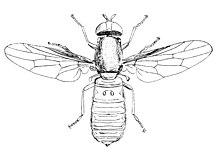Omphralidae
| Scenopinidae | |
|---|---|
 |
|
 |
|
| Scenopinus fenestralis | |
| Scientific classification | |
| Kingdom: | Animalia |
| Phylum: | Arthropoda |
| Class: | Insecta |
| Order: | Diptera |
| Suborder: | Brachycera |
| Superfamily: | Asiloidea |
| Family: |
Scenopinidae Burmeister, 1835 |
| Synonyms | |
|
Omphralidae |
|
Omphralidae
The Scenopinidae or window flies are a small (about 400 described species) family of flies (Diptera), distributed worldwide. In buildings, they are often taken at windows, hence the common name window flies.
The two species with cosmopolitan distributions are associated with the movement of trade goods (Scenopinus fenestralis and S. glabrifrons). Very little is known of the larval biology; larvae have been found associated with stored-grain pests, in nests of birds and rodents, in beetle larvae burrows in trees and shrubs, and in association with therevid larvae in soil. They may be predators of the larvae of other insects. Adults have sponging mouthparts and are found on open flowers.
The adults are small insects, usually with the body no longer than 5 mm, glabrous or slightly hairy and with blackish livery. The head is holoptic in the males of most species, and dichoptic in females. It is provided with three ocelli. The pendulous antennae are composed of three segments the two basal segments short and the third elongated; ‘modified’; with a nonannulated flagellum. The mouthparts are of the sucking type with the labrum (proboscis) very short and with a fleshy apex, and one- or two-segmented maxillary palps. The thorax is moderately convex, with mesoscutal bristles in the Proratinae. The legs are short and lack arolia and empodia. The wings overlap on the abdomen, in the resting phase. The abdomen is large and cylindrical or flattened, composed of seven apparent urites in males and eight in females.
The wing venation differs substantially from that of Therevidae by the number of branches of the media which are reduced to two or three and from that of Bombyliidae in having a simpler radial system. In most of the family, the costa stops short of the wing apex, in correspondence with the termination of R 5 or M 1. An exception is Caenotus, in which the costa extends for the entire margin.
...
Wikipedia
